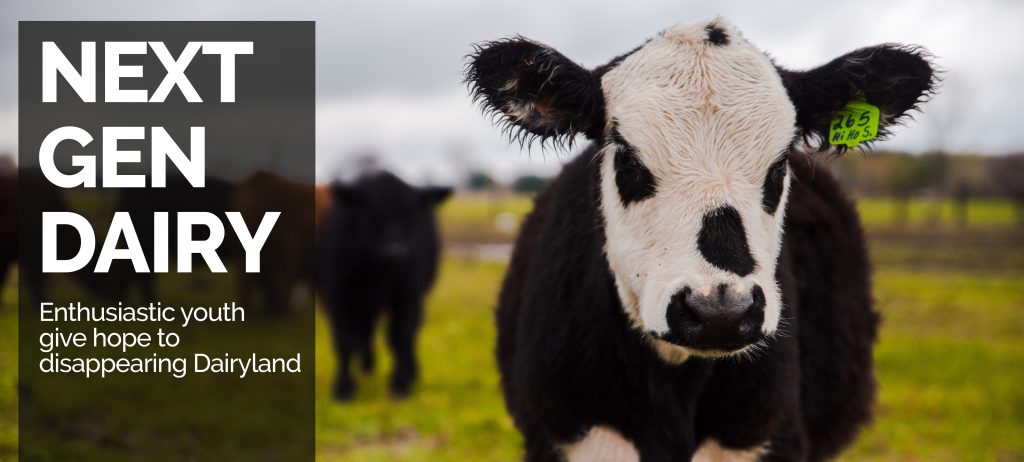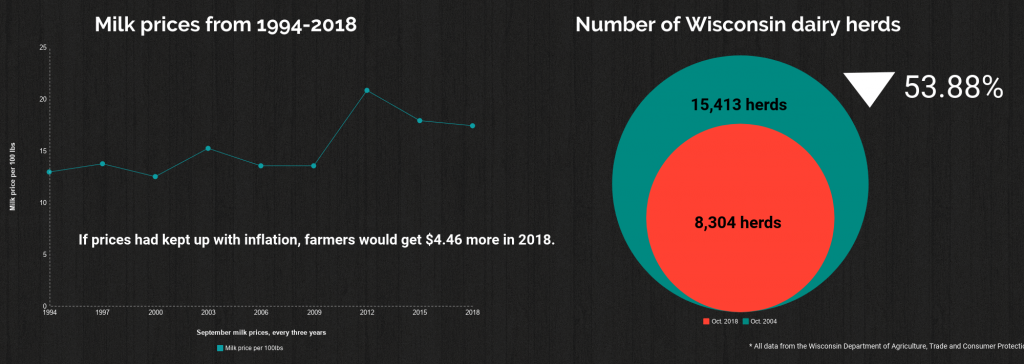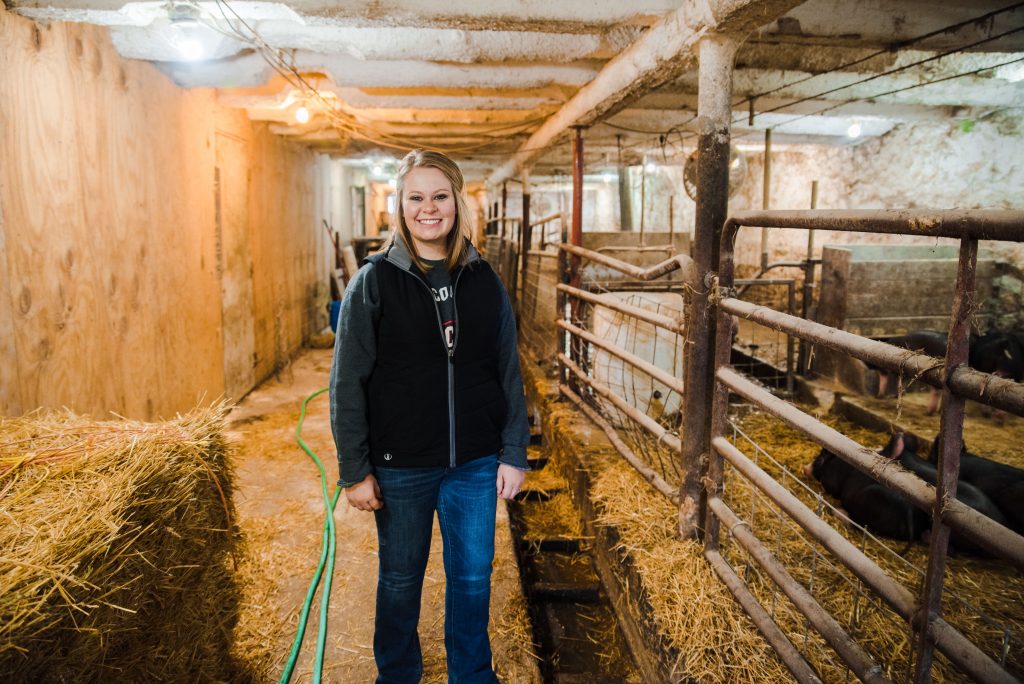
We need support, says 19-year-old Joe Powalisz, an aspiring dairy farmer from northeastern Wisconsin and second-year student in UW-Madison’s Farm and Industry Short Course.
“Right?” he asks, turning to the other side of his dorm room where three of his short-course classmates lean against his desk and nod in agreement.
“Agriculture is what the state is known for. It’s America’s Dairyland. It’s on our [license] plates, and there’s people that try to change things like that, and you’re trying to change history,” adds Jansen McClelland, 19, his classmate. It’s the little guys, small family farms, like ones he’s worked on, he says, that are hurting in today’s market.
Small profit margins are putting pressure on the dairy industry, and those who still choose to become dairy farmers are entering the field at a turning point. Costs are high to even start a farm, let alone sustain it. And unlike their predecessors, the next generation of Wisconsin dairy farmers will need to master new business management techniques and learn to market themselves to a public increasingly skeptical of agricultural practices.
Since 2004, Wisconsin has lost nearly half of its dairy herds. And this past year, Wisconsin saw increased rates of dairy farms exiting the industry — 6 percent loss compared to the average 4 percent in preceding years.

That’s partly because milk prices are so low, and have been for the past four years, explains Mark Stephenson, a dairy markets and policy expert at UW-Madison. In fact, prices are so low that it’s hard for some farmers to break even. In May 2018, farmers received $16.70 for every 100 pounds of milk sold, only $2.84 more than 1990. If milk prices had kept up with inflation, farmers would be paid $26.99 per hundredweight.
Many established farms can weather a year of bad prices by living off their savings, but these low prices have lingered for four years and contributed to farmers exiting the industry at higher rates.
“It’s not a banker that’s pushing them out of the business,” Stephenson says. “They just simply don’t want to continue doing this … they’re losing a little bit of money all the time and that really wears you down after awhile.”
For one thing, Wisconsin farmers are a victim of their own success: advancements allow them to produce more milk than ever before. But at the same time, other parts of the world, such as the European Union, have lifted restrictions on their countries’ production, flooding the world marketplace and driving prices down.
By June 2018, concern had grown so much that Gov. Scott Walker revived the Wisconsin Dairy Task Force — which Stephenson chairs — charged with crafting a strategy to ensure the industry’s future success.
None of this paints a very appealing picture to a young person considering a career in dairy production.
The reality is that starting a farm — buying cows, land and milking technology — requires a lot of money up front.
“I would like to be a farmer a lot more than what I am now. But in today’s world there’s absolutely no way I can start farming with the price of land by my house,” says Waylon Baum, 20, from the northwestern town of Freedom, a second-year student in the Short Course program, which offers college certificates. Instead, he’ll start a hobby farm while working in his family’s machinery shop.
Access to affordable land is the steepest hurdle young farmers face, according to a 2017 survey from the National Young Farmers’ Coalition; lack of it is the number one reason they are prevented from or quit farming.
In 1951, a farm could pay for itself in 14 years, at 2007 prices it would take 33 years; and that rate gets worse when market prices are low, says Trisha Wagner, a UW Extension agriculture educator who works with farmers in Jackson County in western Wisconsin.

If you don’t grow up on a farm, Baum says — looking to his fellow short-course members Jansen McClelland and Ethan Hass, leaning on the desk behind him — or marry into one, he says — looking to Powalisz and eliciting chuckles from the others — then you won’t have your own farm. It costs too much, and you’ll make too little.
It’s really hard to make such a big commitment and buy a dairy farm outright, Stephenson says, but working alongside established farmers or going to school and slowly building up your own equity are both good ways to start.
Powalisz’s path to farming certainly wasn’t traditional, and he definitely wasn’t a farm kid; his dad manages a power plant, and his mom works in an office. It wasn’t until a high school apprenticeship that he found his passion.
He now works part-time with his girlfriend’s family on their dairy farm, in his hometown of Manitowoc in northeastern Wisconsin. But, Powalisz explains, he needed to make money by working off the farm to be a bigger part of it. This winter, he’s going to raise five or six beef steers of his own — the first step to building up his farm equity.
“I’m still trying to figure it out,” Powalisz says of breaking into the industry.
The biggest thing is experience, which he has plenty of, then education, which he’s getting at UW-Madison.
“[Then] word of mouth … and start small, and hopefully it kicks off,” he says. “That’s what I’m trying to do, be successful with raising beef steers … you gotta start somewhere.”
Even young farmers from established operations, such as McClelland, whose father milks 100 cows in Viroqua, a town in the southwest region of Wisconsin, and Hass, whose family milks 200 cows in northeastern Manawa, face significant hurdles before they can take over the family business.
Farm kids rarely inherit a farm outright, says Joy Kirkpatrick, a farm succession planning expert at the University of Wisconsin Center For Dairy Profitability. The older generation can’t afford to give away their business because that’s where their personal equity and retirement funds are tied up.
It’s usually a “part gift, part sale” exchange, Kirkpatrick explains; children inherit part of the business upon their parent’s death and purchase some beforehand — typically at a hefty discount.
“The way the farm industry is now, there’s no way that me and my brother could buy out my parents,” says Hass, 19, who plans to take over the farm with his eldest brother.
Working with a family operation often gives young farmers time to build up assets to borrow against. Hass already has his own herd, equipment and farms 45 acres of his own land — his parents starting giving him cows as birthday presents when he turned 12.
It doesn’t negate all capital costs, but time to build equity and discounts are big advantages for multi-generational farmers. Sometimes, however, they come with strings attached; navigating family dynamics and having honest conversations about finances are tough.
“The harder [conflicts] to address are, is the older generation ready to let go and watch someone else make decisions and transfer that management and responsibility to that next generation?” Kirkpatrick says.
McClelland says he and his father haven’t discussed the future yet — he’s not 100 percent certain he’ll farm forever. Hass and his brother have plans for how to structure the farm’s finances but they’re waiting until he finishes school to finalize anything.
If you can clear financial hurdles, running a farm is still really hard work.
Like generations before them, the next crop of farmers will need to know basics of veterinary science and animal care, environmental concerns and crop production. But with increasingly tight profit margins and fast-paced advancements, the next generation will need a variety of skills to make their businesses as efficient as possible.
Understanding technology, the short-course students stressed, is really important. You definitely can’t milk cows by hand anymore, Hass says.
“If your farm doesn’t stay up with the new type, like keep improving … you’re not going to be able to survive doing it the old style way,” he says.
Maybe we should be learning more about robotics and robotic milkers, Powalisz asks the others, adding that that’s the future of the industry, anyway.
Powalisz has already put what he learned at the short course to good use. Last year, he suggested that his girlfriend’s father switch how they prepare crop fields for planting. One day Powalisz showed up to work, he explains, and the new equipment was waiting.
On the business side, farms have started marketing themselves to stand out in the marketplace and capitalize on consumer trends.
“Back in the old days maybe they didn’t have Facebook or social media or anything to share about their farms,” says Dani Angotti, 21, a student at UW-River Falls studying agriculture education and Baum’s girlfriend. “I know my grandpa [who was a dairy farmer] didn’t have to market his farm when he was back in his prime. He just had to milk his cows, and the milk producers would come pick up his milk, and that would be that.”
By marketing himself directly to local consumers, Baum says he could actually make his hobby farm more profitable. Powalisz says his agricultural commodities and marketing class could help him diversify a future farms’ profit streams and pivot to a Plan B if he can’t survive as a dairy farm.
One consumer-driven trend, going organic, has become a popular option for struggling Wisconsin farms. Baum said he’d consider going organic to earn more, but he’d never buy organic himself. McClelland is opposed to organic all together, despite living just towns over from Organic Valley, a popular cooperative based in western Wisconsin.
“It’s really not much different than what everyone else does. It’s just a label. I could put a label on organic and no one would know,” he says.
“[But] you can’t teach that to these people who have never seen a cow,” Hass adds.

The industry needs to better job of bridging the gap between producer and consumer, as well as educating people about where their food comes from, Angotti says. That’s one of the reasons she wants to be an agriculture teacher — one who believes agriculture education should be a required course for all Wisconsin students.
“I don’t think it’s good when people don’t understand the truth about agriculture, where their food comes from,” she says. “I think that’s one of the biggest things that people need to learn about because that’s ultimately what keeps us surviving on Earth.”
Despite precarious times for the industry, Powalisz says that 50 years from now, as long as he’s not dead, he’ll be farming. Getting up at 3:45 a.m. to milk cows before work, and coming home to milk on the farm again is a “little slice of heaven.”
And Wisconsin’s robust dairy industry, Stephenson assures, isn’t going anywhere.
“You go to any other state and they’re selling Wisconsin cheese,” Angotti says. “I went to the Mall of America, and they have a Wisconsin cheese stand … How can we not be America’s Dairyland if other states are having Wisconsin cheese?”
Wagner echoed Angotti’s enthusiasm, touting the accomplishment of the young farmers she has worked with. The next generation, she says, actually offers a lot of new talent, education and skills that could improve the industry.
“I’ve seen the oncoming generation … whether they’re from the family farm or a new, being able to handle [new challenges] so well,” she says. “If an owner of an older generation can recognize that and work with the younger generation, whether it’s a family member or not, that’s gonna be huge for the future of that business.”

Nina, the online editor, is a senior studying history and journalism & mass communication. When she's not frolicking with the cows, she spends a lot of time on Twitter. Tweet her, @bertelsen_nina.